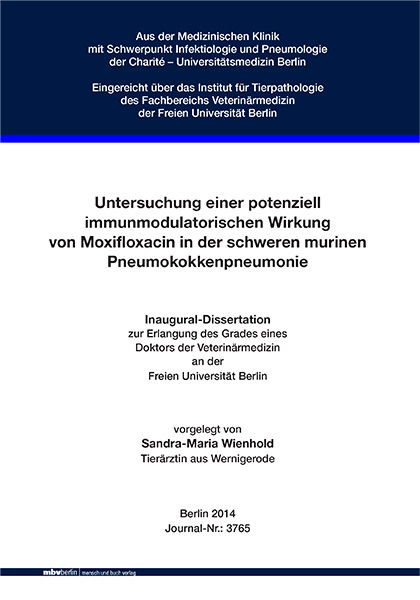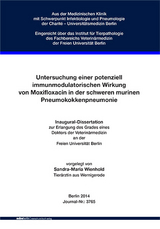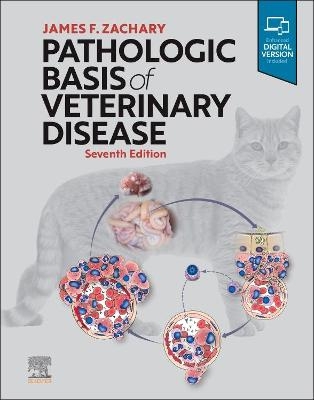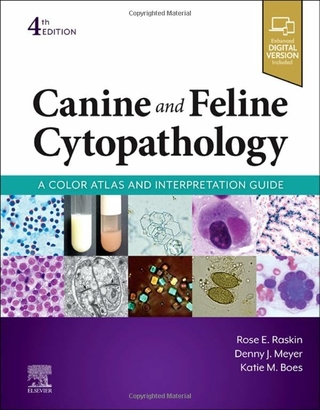Untersuchung einer potenziell immunmodulatorischen Wirkung von Moxifloxa-cin in der schweren murinen Pneumokokkenpneumonie
Seiten
2015
|
1. Aufl.
Mensch & Buch (Verlag)
978-3-86387-623-4 (ISBN)
Mensch & Buch (Verlag)
978-3-86387-623-4 (ISBN)
- Keine Verlagsinformationen verfügbar
- Artikel merken
Investigation of potential immunomodulatory effects of moxifloxacin in severe murine pneumococcal pneumonia
With regard to causes of morbidity and mortality worldwide, community-acquired pneumonia holds the highest significance and Streptococcus pneumoniae (S. pneumoniae) is the most prevalent causative pathogen of community-acquired pneumonia. Despite adequate antibiotic therapy and constant endeavour to improve the clinical outcome of high risk patients, existing treatment and drug regimens are still insufficient, considering the high mortality (above 20 %) for immunocompetent patients in intensive care units hospitalized for severe community-acquired pneumonia. The main contributing factor to an adverse outcome of patients suffering from severe pneumonia is an excessive activation of the innate immune system, which leads to the development of acute respiratory failure, sepsis and multiple organ failure. Thus, limitation of exaggerated inflammatory reactions, combined with an effective antibiotic treatment might improve the outcome of affected patients.
Efficient therapeutic protocols of various respiratory infections utilize Quinolones. Apart from their well described antimicrobial characteristics, Quinolones were suggested to exert anti-inflammatory effects. Particularly moxifloxacin has been shown to inhibit the release of proin-flammatory cytokines in in vitro experiments, using human monocytes and human alveolar epithelial cells stimulated with heat-inactivated pneumococci or lipopolysaccharides. However, clinical studies demonstrated a less clear picture. In a retrospective study, patients with severe community-acquired pneumonia were treated with moxifloxacin, which resulted in improved outcome as compared to monotherapy with -lactam antibiotics. It was hypothesized that potential immunomodulatory features of moxifloxacin were responsible for this improvement of patient survival. In contrast, a prospective study showed no clinical benefit for patients with sepsis, who were treated with moxifloxacin in addition to carbapenem antibiotics. This study aimed at analysing the impact of moxifloxacin on the inflammatory host response in ex vivo cultured intact human lung tissue and in a murine model of severe pneumococcal pneumonia. Therefore, ex vivo cultured human lung tissue was stimulated with TNF- or infected with S. pneumoniae, treated with ampicillin, moxifloxacin or solvent and proinflammatory cytokines were quantified in the supernatant. For ampicillin which is one standard treatment in community-acquired pneumonia, anti-inflammatory effects have not been described so far. Therefore, it was used as reference antibiotic in this study. Upon stimulation with TNF- human lung tissue produced IL-6 and IL-8, which was reduced by moxifloxacin but not by ampicillin. Infection with S. pneumoniae also induced IL-6 and IL-8 production in human lung tissue which was not influenced by treatment with moxifloxacin or ampicillin. Additionally, a murine model was established, in which antibiotic treatment with ampicillin or moxifloxacin was applied in severe pneumococcal pneumonia to mimic the clinical treatment initiated in the emergency department. Mice infected with a lethal dosage of S. pneumoniae were treated in 12-hour intervals with ampicillin, moxifloxacin or solvent, starting 24 hours post infection. In addition, sham infected and solvent treated animals were investigated. At specified time points post infection, the bacterial burden in lung, blood and spleen was analysed. Cytokine levels were measured in bronchoalveolar lavage fluid and blood plasma. Furthermore, proinflammatory gene regulation in murine lung tissue was investigated by real-time polymerase chain reaction. Bronchoalveolar lavage fluid and blood leukocytes were differentiated and pulmonary vascular permeability was determined. Additionally, lung tissue from infected mice was histologically analysed. Upon infection with S. pneumoniae, mice developed severe pneumonia within 24 hours post infection. Antibiotic treated mice were rescued from developing acute respiratory distress syndrome and sepsis, and recovered from clinical signs of pneumonia within the observation period. Pulmonary bacterial burden was lower in moxifloxacin treated mice in contrast to ampicillin from 36 hours post infection on, and fewer cases with bacteraemia were observed when compared with ampicillin treated mice. At 36 hours post infection, ampicillin treated mice showed increased pulmonary vascular permeability, which could not be attributed to the lower bacterial burden in moxifloxacin treated mice. This was shown by an additionally investigated group of mice treated with moxifloxacin and ampicillin simultaneously. Animals in this group displayed equally high permeability as mice with ampicillin monotherapy. Bronchoalveolar lavage fluid and blood cytokine levels, proinflammatory gene expression, blood leukocytes and morphologic lung injury scores were similar in mice treated with moxifloxacin or ampicillin. To estimate a potential effect of moxifloxacin on the integrity of the cellular monolayer, transcellular electrical resistance of human umbilical vein endothelial cell monolayers was measured in the presence of moxifloxacin or ampicillin with or without thrombin stimulation. Moxifloxacin exerted no direct stabilising effects on the endothelial barrier, and it also did not reduce thrombin-induced disruption of integrity. The same applied to ampicillin.
In summary, in human lung tissue moxifloxacin treatment reduced TNF-α induced inflammation in contrast to ampicillin. However, ampicillin and moxifloxacin showed similar effects in pneumococci-induced inflammation of human lung tissue and in severe murine pneumococcal pneumonia. Nevertheless, treatment with moxifloxacin reduced pulmonary bacterial load and bacteraemia in contrast to ampicillin. Pulmonary vascular permeability in the acute phase of murine pneumococcal pneumonia was enhanced by ampicillin in contrast to moxifloxacin treatment, which was independent from effects of moxifloxacin. Die ambulant erworbene Pneumonie ist die häufigste tödlich verlaufende Infektionskrankheit weltweit. Streptococcus pneumoniae (S. pneumoniae) ist der mit Abstand häufigste Erreger der ambulant erworbenen Pneumonie. Trotz spezifischer antimikrobieller Therapien und stetiger Bemühungen, die Behandlung von Risikopatienten zu verbessern, wird die Mortalität bei immunkompetenten, antibiotisch adäquat therapierten Patienten mit schwerer Pneumonie auf Intensivstationen weiterhin mit über 20 % angegeben. Die unkontrollierte Aktivierung des Immunsystems scheint bei der schweren Pneumonie eine zentrale Rolle in der Entstehung eines akuten Lungenversagens sowie von Sepsis und Multiorganversagen zu spielen. Daher könnte die gezielte Limitierung überschießender Entzündungsreaktionen kombiniert mit einer effektiven antimikrobiellen Therapie den Verlauf der schweren Pneumonie begünstigen.
Chinolone könnten neben ihren gut untersuchten antimikrobiellen Eigenschaften auch antiinflammatorisch wirksam sein. Besonders Moxifloxacin, das unter anderem in der Behandlung der Pneumonie eingesetzt wird, hemmte in vitro die Freisetzung von proinflammatorischen Zytokinen aus humanen Monozyten und humanen Alveolarepithelzellen nach Stimulation mit hitzeinaktivierten Pneumokokken oder Lipopolysacchariden, jedoch gibt es wenig Evidenz aus Untersuchungen mit lebenden Bakterien. Klinische Untersuchungen zeichnen ein weniger eindeutiges Bild. Während in einer retrospektiven klinischen Studie ein besseres Überleben von Patienten mit schwerer ambulant erworbener Pneumonie unter Moxifloxacin-Therapie, verglichen mit Laktam-Monotherapie, beobachtet wurde, konnte prospektiv kein klinischer Nutzen für Patienten mit Sepsis nachgewiesen werden, die zusätzlich zu einer Carbapenem-Therapie Moxifloxacin erhielten. Ziel der vorliegenden Dissertationsarbeit war es daher experimentell zu prüfen, ob für Moxifloxacin immunmodulatorische Eigenschaften in Modellen der Pneumokokkenpneumonie nachweisbar sind. Hierfür wurden in einem ex vivo Modell vitale humane Lungenproben mit TNF- oder S. pneumoniae stimuliert und mit Ampicillin, Moxifloxacin oder Lösungsmittel behandelt und der Einfluss von Moxifloxacin im Vergleich zu Ampicillin, einer der Standardtherapien der ambulant erworbenen Pneumonie, auf die ausgelöste Entzündungsreaktion bestimmt. Für Ampicillin sind keine auf das Immunsystem wirkenden Eigenschaften bekannt. Nach der Stimulation mit TNF- wurde vermehrt IL-6 und IL-8 produziert. Die Behandlung mit Moxifloxacin resultierte in einer verminderten Bildung von IL-6 im Gegensatz zur Behandlung mit Ampicillin. Die Infektion mit S. pneumoniae führte ebenfalls zu einer gesteigerten Produktion der untersuchten Zytokine, die jedoch durch Behandlung mit Moxifloxacin oder Ampicillin nicht reduziert wurde.
Darüber hinaus wurde die Moxifloxacin-Therapie in der murinen Pneumokokkenpneumonie im Vergleich zu einer Behandlung mit Ampicillin hinsichtlich Parametern der Entzündungsreaktion, der Erregerelimination, pulmonalvaskulärer Schrankenstörung, histopathologischer Lungenveränderungen und klinischem Verlauf der Infektion untersucht. Mäuse wurden mit S. pneumoniae infiziert und beginnend 24 Stunden nach der Infektion in 12 Stunden-Intervallen mit Ampicillin, Moxifloxacin oder Lösungsmittel behandelt. Zusätzlich dienten Mäuse als Kontrolltiere, die mit Lösungsmittel scheininfiziert und behandelt wurden. Die infizierten Mäuse entwickelten innerhalb von 24 Stunden eine schwere Pneumonie. Alle antibiotisch behandelten Tiere erholten sich im Beobachtungszeitraum fast vollständig von klinischen Zeichen der Pneumonie. Die Behandlung mit Moxifloxacin führte zu einer effektiveren pulmonalen Erregerelimination ab 36 Stunden nach der Infektion sowie zu einer besseren Reduktion von Bakteriämien im Gegensatz zu Ampicillin. Mit Ampicillin behandelte Mäuse zeigten eine erhöhte pulmonalvaskuläre Permeabilität 36 Stunden nach der Infektion im Gegensatz zu Moxifloxacin behandelten Mäusen. Dabei war die verminderte Erregerlast in den mit Moxifloxacin behandelten Tieren nicht ursächlich für die niedrigere pulmonalvaskuläre Permeabilität, was durch Untersuchungen an einer zusätzlichen Versuchsgruppe gezeigt werden konnte, die gleichzeitig mit Ampicillin und Moxifloxacin behandelt wurde. Die kombinierte Behandlung führte zu einer mit der Ampicillin-Monotherapie vergleichbaren Permeabilität. Auch die Effekte beider Antibiotika bezüglich aller weiteren untersuchten Parameter waren vergleichbar. Insbesondere war die pulmonale und systemische Inflammation trotz geringerer Erregerdichte unter Moxifloxacin-Therapie im Gegensatz zur Ampicillin-Therapie nicht reduziert. Zusätzlich wurde der direkte Einfluss von Moxifloxacin und Ampicillin auf die Integrität eines Endothelzellmonolayers mit oder ohne Thrombin-Stimulation durch Messung des transzellulären elektrischen Widerstands getestet. Moxifloxacin erhöhte in vitro weder die basale Integrität des Monolayers, noch reduzierte es die durch Thrombin verursachte Störung der interzellulären Kontakte. Auch Ampicillin hatte keinen Einfluss auf die Stabilität der Barriere.
Die Ergebnisse der vorliegenden Studie zeigten, dass Moxifloxacin die TNF-induzierte Inflammation in humanem Lungengewebe im Gegensatz zu Ampicillin reduzierte. Jedoch ließen sich weder in humanem Lungengewebe, noch in der schweren murinen Pneumonie nach Infektion mit S. pneumoniae antiinflammatorische Eigenschaften von Moxifloxacin im Vergleich zu Ampicillin nachweisen. Moxifloxacin war Ampicillin bezüglich der Eliminierung pulmonaler Erregerlast und Bakteriämien überlegen. Ampicillin-behandelte Tiere wiesen allerdings eine erhöhte pulmonalvaskuläre Permeabilität in der akuten Phase der Pneumonie auf und diese Beobachtung war unabhängig von Effekten des Moxifloxacin.
With regard to causes of morbidity and mortality worldwide, community-acquired pneumonia holds the highest significance and Streptococcus pneumoniae (S. pneumoniae) is the most prevalent causative pathogen of community-acquired pneumonia. Despite adequate antibiotic therapy and constant endeavour to improve the clinical outcome of high risk patients, existing treatment and drug regimens are still insufficient, considering the high mortality (above 20 %) for immunocompetent patients in intensive care units hospitalized for severe community-acquired pneumonia. The main contributing factor to an adverse outcome of patients suffering from severe pneumonia is an excessive activation of the innate immune system, which leads to the development of acute respiratory failure, sepsis and multiple organ failure. Thus, limitation of exaggerated inflammatory reactions, combined with an effective antibiotic treatment might improve the outcome of affected patients.
Efficient therapeutic protocols of various respiratory infections utilize Quinolones. Apart from their well described antimicrobial characteristics, Quinolones were suggested to exert anti-inflammatory effects. Particularly moxifloxacin has been shown to inhibit the release of proin-flammatory cytokines in in vitro experiments, using human monocytes and human alveolar epithelial cells stimulated with heat-inactivated pneumococci or lipopolysaccharides. However, clinical studies demonstrated a less clear picture. In a retrospective study, patients with severe community-acquired pneumonia were treated with moxifloxacin, which resulted in improved outcome as compared to monotherapy with -lactam antibiotics. It was hypothesized that potential immunomodulatory features of moxifloxacin were responsible for this improvement of patient survival. In contrast, a prospective study showed no clinical benefit for patients with sepsis, who were treated with moxifloxacin in addition to carbapenem antibiotics. This study aimed at analysing the impact of moxifloxacin on the inflammatory host response in ex vivo cultured intact human lung tissue and in a murine model of severe pneumococcal pneumonia. Therefore, ex vivo cultured human lung tissue was stimulated with TNF- or infected with S. pneumoniae, treated with ampicillin, moxifloxacin or solvent and proinflammatory cytokines were quantified in the supernatant. For ampicillin which is one standard treatment in community-acquired pneumonia, anti-inflammatory effects have not been described so far. Therefore, it was used as reference antibiotic in this study. Upon stimulation with TNF- human lung tissue produced IL-6 and IL-8, which was reduced by moxifloxacin but not by ampicillin. Infection with S. pneumoniae also induced IL-6 and IL-8 production in human lung tissue which was not influenced by treatment with moxifloxacin or ampicillin. Additionally, a murine model was established, in which antibiotic treatment with ampicillin or moxifloxacin was applied in severe pneumococcal pneumonia to mimic the clinical treatment initiated in the emergency department. Mice infected with a lethal dosage of S. pneumoniae were treated in 12-hour intervals with ampicillin, moxifloxacin or solvent, starting 24 hours post infection. In addition, sham infected and solvent treated animals were investigated. At specified time points post infection, the bacterial burden in lung, blood and spleen was analysed. Cytokine levels were measured in bronchoalveolar lavage fluid and blood plasma. Furthermore, proinflammatory gene regulation in murine lung tissue was investigated by real-time polymerase chain reaction. Bronchoalveolar lavage fluid and blood leukocytes were differentiated and pulmonary vascular permeability was determined. Additionally, lung tissue from infected mice was histologically analysed. Upon infection with S. pneumoniae, mice developed severe pneumonia within 24 hours post infection. Antibiotic treated mice were rescued from developing acute respiratory distress syndrome and sepsis, and recovered from clinical signs of pneumonia within the observation period. Pulmonary bacterial burden was lower in moxifloxacin treated mice in contrast to ampicillin from 36 hours post infection on, and fewer cases with bacteraemia were observed when compared with ampicillin treated mice. At 36 hours post infection, ampicillin treated mice showed increased pulmonary vascular permeability, which could not be attributed to the lower bacterial burden in moxifloxacin treated mice. This was shown by an additionally investigated group of mice treated with moxifloxacin and ampicillin simultaneously. Animals in this group displayed equally high permeability as mice with ampicillin monotherapy. Bronchoalveolar lavage fluid and blood cytokine levels, proinflammatory gene expression, blood leukocytes and morphologic lung injury scores were similar in mice treated with moxifloxacin or ampicillin. To estimate a potential effect of moxifloxacin on the integrity of the cellular monolayer, transcellular electrical resistance of human umbilical vein endothelial cell monolayers was measured in the presence of moxifloxacin or ampicillin with or without thrombin stimulation. Moxifloxacin exerted no direct stabilising effects on the endothelial barrier, and it also did not reduce thrombin-induced disruption of integrity. The same applied to ampicillin.
In summary, in human lung tissue moxifloxacin treatment reduced TNF-α induced inflammation in contrast to ampicillin. However, ampicillin and moxifloxacin showed similar effects in pneumococci-induced inflammation of human lung tissue and in severe murine pneumococcal pneumonia. Nevertheless, treatment with moxifloxacin reduced pulmonary bacterial load and bacteraemia in contrast to ampicillin. Pulmonary vascular permeability in the acute phase of murine pneumococcal pneumonia was enhanced by ampicillin in contrast to moxifloxacin treatment, which was independent from effects of moxifloxacin. Die ambulant erworbene Pneumonie ist die häufigste tödlich verlaufende Infektionskrankheit weltweit. Streptococcus pneumoniae (S. pneumoniae) ist der mit Abstand häufigste Erreger der ambulant erworbenen Pneumonie. Trotz spezifischer antimikrobieller Therapien und stetiger Bemühungen, die Behandlung von Risikopatienten zu verbessern, wird die Mortalität bei immunkompetenten, antibiotisch adäquat therapierten Patienten mit schwerer Pneumonie auf Intensivstationen weiterhin mit über 20 % angegeben. Die unkontrollierte Aktivierung des Immunsystems scheint bei der schweren Pneumonie eine zentrale Rolle in der Entstehung eines akuten Lungenversagens sowie von Sepsis und Multiorganversagen zu spielen. Daher könnte die gezielte Limitierung überschießender Entzündungsreaktionen kombiniert mit einer effektiven antimikrobiellen Therapie den Verlauf der schweren Pneumonie begünstigen.
Chinolone könnten neben ihren gut untersuchten antimikrobiellen Eigenschaften auch antiinflammatorisch wirksam sein. Besonders Moxifloxacin, das unter anderem in der Behandlung der Pneumonie eingesetzt wird, hemmte in vitro die Freisetzung von proinflammatorischen Zytokinen aus humanen Monozyten und humanen Alveolarepithelzellen nach Stimulation mit hitzeinaktivierten Pneumokokken oder Lipopolysacchariden, jedoch gibt es wenig Evidenz aus Untersuchungen mit lebenden Bakterien. Klinische Untersuchungen zeichnen ein weniger eindeutiges Bild. Während in einer retrospektiven klinischen Studie ein besseres Überleben von Patienten mit schwerer ambulant erworbener Pneumonie unter Moxifloxacin-Therapie, verglichen mit Laktam-Monotherapie, beobachtet wurde, konnte prospektiv kein klinischer Nutzen für Patienten mit Sepsis nachgewiesen werden, die zusätzlich zu einer Carbapenem-Therapie Moxifloxacin erhielten. Ziel der vorliegenden Dissertationsarbeit war es daher experimentell zu prüfen, ob für Moxifloxacin immunmodulatorische Eigenschaften in Modellen der Pneumokokkenpneumonie nachweisbar sind. Hierfür wurden in einem ex vivo Modell vitale humane Lungenproben mit TNF- oder S. pneumoniae stimuliert und mit Ampicillin, Moxifloxacin oder Lösungsmittel behandelt und der Einfluss von Moxifloxacin im Vergleich zu Ampicillin, einer der Standardtherapien der ambulant erworbenen Pneumonie, auf die ausgelöste Entzündungsreaktion bestimmt. Für Ampicillin sind keine auf das Immunsystem wirkenden Eigenschaften bekannt. Nach der Stimulation mit TNF- wurde vermehrt IL-6 und IL-8 produziert. Die Behandlung mit Moxifloxacin resultierte in einer verminderten Bildung von IL-6 im Gegensatz zur Behandlung mit Ampicillin. Die Infektion mit S. pneumoniae führte ebenfalls zu einer gesteigerten Produktion der untersuchten Zytokine, die jedoch durch Behandlung mit Moxifloxacin oder Ampicillin nicht reduziert wurde.
Darüber hinaus wurde die Moxifloxacin-Therapie in der murinen Pneumokokkenpneumonie im Vergleich zu einer Behandlung mit Ampicillin hinsichtlich Parametern der Entzündungsreaktion, der Erregerelimination, pulmonalvaskulärer Schrankenstörung, histopathologischer Lungenveränderungen und klinischem Verlauf der Infektion untersucht. Mäuse wurden mit S. pneumoniae infiziert und beginnend 24 Stunden nach der Infektion in 12 Stunden-Intervallen mit Ampicillin, Moxifloxacin oder Lösungsmittel behandelt. Zusätzlich dienten Mäuse als Kontrolltiere, die mit Lösungsmittel scheininfiziert und behandelt wurden. Die infizierten Mäuse entwickelten innerhalb von 24 Stunden eine schwere Pneumonie. Alle antibiotisch behandelten Tiere erholten sich im Beobachtungszeitraum fast vollständig von klinischen Zeichen der Pneumonie. Die Behandlung mit Moxifloxacin führte zu einer effektiveren pulmonalen Erregerelimination ab 36 Stunden nach der Infektion sowie zu einer besseren Reduktion von Bakteriämien im Gegensatz zu Ampicillin. Mit Ampicillin behandelte Mäuse zeigten eine erhöhte pulmonalvaskuläre Permeabilität 36 Stunden nach der Infektion im Gegensatz zu Moxifloxacin behandelten Mäusen. Dabei war die verminderte Erregerlast in den mit Moxifloxacin behandelten Tieren nicht ursächlich für die niedrigere pulmonalvaskuläre Permeabilität, was durch Untersuchungen an einer zusätzlichen Versuchsgruppe gezeigt werden konnte, die gleichzeitig mit Ampicillin und Moxifloxacin behandelt wurde. Die kombinierte Behandlung führte zu einer mit der Ampicillin-Monotherapie vergleichbaren Permeabilität. Auch die Effekte beider Antibiotika bezüglich aller weiteren untersuchten Parameter waren vergleichbar. Insbesondere war die pulmonale und systemische Inflammation trotz geringerer Erregerdichte unter Moxifloxacin-Therapie im Gegensatz zur Ampicillin-Therapie nicht reduziert. Zusätzlich wurde der direkte Einfluss von Moxifloxacin und Ampicillin auf die Integrität eines Endothelzellmonolayers mit oder ohne Thrombin-Stimulation durch Messung des transzellulären elektrischen Widerstands getestet. Moxifloxacin erhöhte in vitro weder die basale Integrität des Monolayers, noch reduzierte es die durch Thrombin verursachte Störung der interzellulären Kontakte. Auch Ampicillin hatte keinen Einfluss auf die Stabilität der Barriere.
Die Ergebnisse der vorliegenden Studie zeigten, dass Moxifloxacin die TNF-induzierte Inflammation in humanem Lungengewebe im Gegensatz zu Ampicillin reduzierte. Jedoch ließen sich weder in humanem Lungengewebe, noch in der schweren murinen Pneumonie nach Infektion mit S. pneumoniae antiinflammatorische Eigenschaften von Moxifloxacin im Vergleich zu Ampicillin nachweisen. Moxifloxacin war Ampicillin bezüglich der Eliminierung pulmonaler Erregerlast und Bakteriämien überlegen. Ampicillin-behandelte Tiere wiesen allerdings eine erhöhte pulmonalvaskuläre Permeabilität in der akuten Phase der Pneumonie auf und diese Beobachtung war unabhängig von Effekten des Moxifloxacin.
| Erscheinungsdatum | 23.06.2017 |
|---|---|
| Verlagsort | Berlin |
| Sprache | deutsch |
| Maße | 148 x 210 mm |
| Einbandart | gebunden |
| Themenwelt | Veterinärmedizin ► Vorklinik |
| Veterinärmedizin ► Klinische Fächer | |
| Schlagworte | acute respiratory distress syndrome • Animal Models • Antibiotics • Bacterial Pneumonia • Immuno-modulation • immunomodulatory properties • inflammation • lungs • mice • Streptococcus pneumoniae |
| ISBN-10 | 3-86387-623-7 / 3863876237 |
| ISBN-13 | 978-3-86387-623-4 / 9783863876234 |
| Zustand | Neuware |
| Informationen gemäß Produktsicherheitsverordnung (GPSR) | |
| Haben Sie eine Frage zum Produkt? |
Mehr entdecken
aus dem Bereich
aus dem Bereich
A Color Atlas and Interpretation Guide
Buch | Hardcover (2022)
Saunders (Verlag)
CHF 229,95



